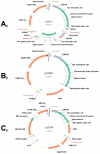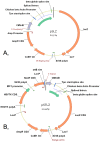Novel method to load multiple genes onto a mammalian artificial chromosome
- PMID: 24454889
- PMCID: PMC3893256
- DOI: 10.1371/journal.pone.0085565
Novel method to load multiple genes onto a mammalian artificial chromosome
Abstract
Mammalian artificial chromosomes are natural chromosome-based vectors that may carry a vast amount of genetic material in terms of both size and number. They are reasonably stable and segregate well in both mitosis and meiosis. A platform artificial chromosome expression system (ACEs) was earlier described with multiple loading sites for a modified lambda-integrase enzyme. It has been shown that this ACEs is suitable for high-level industrial protein production and the treatment of a mouse model for a devastating human disorder, Krabbe's disease. ACEs-treated mutant mice carrying a therapeutic gene lived more than four times longer than untreated counterparts. This novel gene therapy method is called combined mammalian artificial chromosome-stem cell therapy. At present, this method suffers from the limitation that a new selection marker gene should be present for each therapeutic gene loaded onto the ACEs. Complex diseases require the cooperative action of several genes for treatment, but only a limited number of selection marker genes are available and there is also a risk of serious side-effects caused by the unwanted expression of these marker genes in mammalian cells, organs and organisms. We describe here a novel method to load multiple genes onto the ACEs by using only two selectable marker genes. These markers may be removed from the ACEs before therapeutic application. This novel technology could revolutionize gene therapeutic applications targeting the treatment of complex disorders and cancers. It could also speed up cell therapy by allowing researchers to engineer a chromosome with a predetermined set of genetic factors to differentiate adult stem cells, embryonic stem cells and induced pluripotent stem (iPS) cells into cell types of therapeutic value. It is also a suitable tool for the investigation of complex biochemical pathways in basic science by producing an ACEs with several genes from a signal transduction pathway of interest.
Conflict of interest statement
Figures






Similar articles
-
De novo formed satellite DNA-based mammalian artificial chromosomes and their possible applications.Chromosome Res. 2015 Feb;23(1):143-57. doi: 10.1007/s10577-014-9458-0. Chromosome Res. 2015. PMID: 25596828 Review.
-
A combined artificial chromosome-stem cell therapy method in a model experiment aimed at the treatment of Krabbe's disease in the Twitcher mouse.Cell Mol Life Sci. 2008 Nov;65(23):3830-8. doi: 10.1007/s00018-008-8442-2. Cell Mol Life Sci. 2008. PMID: 18850314 Free PMC article.
-
Chromosome engineering with lambda-integrase mediated recombination system: the ACE system.Methods Mol Biol. 2011;738:141-9. doi: 10.1007/978-1-61779-099-7_10. Methods Mol Biol. 2011. PMID: 21431725
-
Generation of induced pluripotent stem cells by using a mammalian artificial chromosome expression system.Acta Biol Hung. 2014 Sep;65(3):331-45. doi: 10.1556/ABiol.65.2014.3.9. Acta Biol Hung. 2014. PMID: 25194736
-
Development of mammalian artificial chromosomes for the treatment of genetic diseases: Sandhoff and Krabbe diseases.Expert Opin Biol Ther. 2005 Feb;5(2):195-206. doi: 10.1517/14712598.5.2.195. Expert Opin Biol Ther. 2005. PMID: 15757381 Review.
Cited by
-
Engineering Synthetic Chromosomes by Sequential Loading of Multiple Genomic Payloads over 100 Kilobase Pairs in Size.Mol Ther Methods Clin Dev. 2019 Apr 29;13:463-473. doi: 10.1016/j.omtm.2019.04.006. eCollection 2019 Jun 14. Mol Ther Methods Clin Dev. 2019. PMID: 31193384 Free PMC article.
-
A novel system for simultaneous or sequential integration of multiple gene-loading vectors into a defined site of a human artificial chromosome.PLoS One. 2014 Oct 10;9(10):e110404. doi: 10.1371/journal.pone.0110404. eCollection 2014. PLoS One. 2014. PMID: 25303219 Free PMC article.
-
Human Artificial Chromosome with Regulated Centromere: A Tool for Genome and Cancer Studies.ACS Synth Biol. 2018 Sep 21;7(9):1974-1989. doi: 10.1021/acssynbio.8b00230. Epub 2018 Aug 16. ACS Synth Biol. 2018. PMID: 30075081 Free PMC article. Review.
-
De novo formed satellite DNA-based mammalian artificial chromosomes and their possible applications.Chromosome Res. 2015 Feb;23(1):143-57. doi: 10.1007/s10577-014-9458-0. Chromosome Res. 2015. PMID: 25596828 Review.
-
Human artificial chromosomes for future biomedicine.Cell Cycle. 2015;14(10):1494. doi: 10.1080/15384101.2015.1032647. Cell Cycle. 2015. PMID: 25928730 Free PMC article. No abstract available.
References
-
- Seymour LW, Fisher KD (2009) Preclinical Screening of Gene Therapy in Human Tissues. Human Gene Therapy 20: 291–292. - PubMed
-
- Ascenzioni F, Donini P, Lipps HJ (1997) Mammalian artificial chromosomes–vectors for somatic gene therapy. Cancer Lett 118: 135–142. - PubMed
-
- Basu J, Willard HF (2006) Human artificial chromosomes: potential applications and clinical considerations. Pediatr Clin North Am 53: 843–853. - PubMed
-
- Bridger JM (2004) Mammalian artificial chromosomes: modern day feats of engineering–Isambard Kingdom Brunel style. Cytogenet Genome Res 107: 5–8. - PubMed
-
- Cooke H (2001) Mammalian artificial chromosomes as vectors: progress and prospects. Cloning Stem Cells 3: 243–249. - PubMed
Publication types
MeSH terms
Substances
LinkOut - more resources
Full Text Sources
Other Literature Sources
Medical

